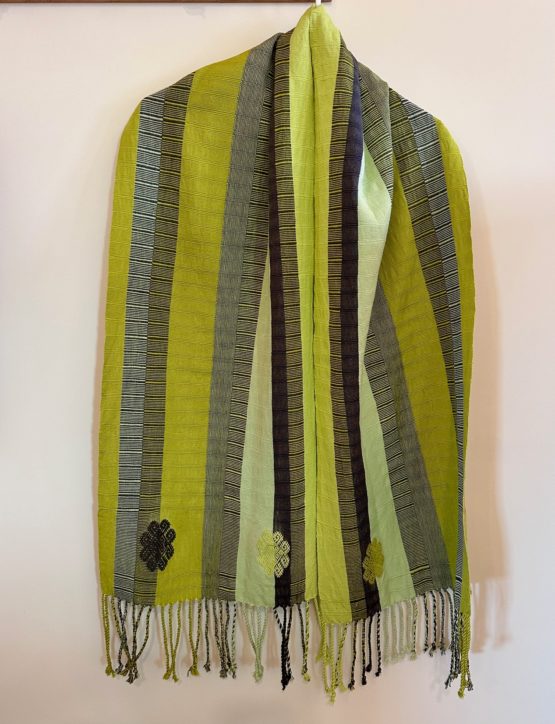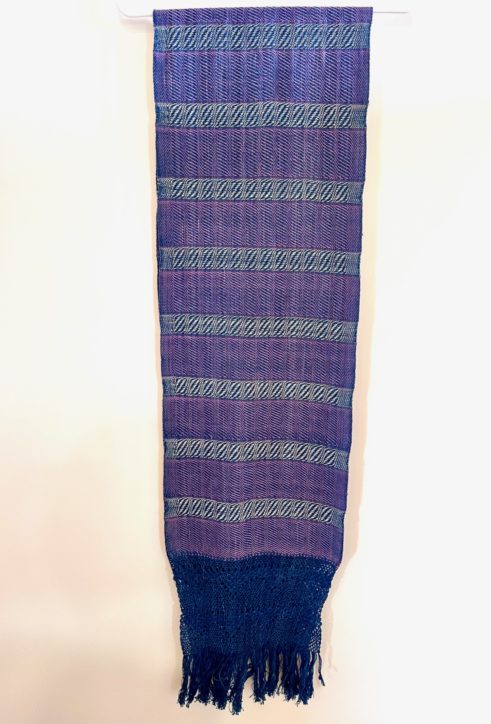I spent the morning with Estela Montaño and Edith Montaño Martínez at their home and workshop in Teotitlán del Valle, Oaxaca. Xi-Guía is the name of the town in Zapteco, the indigenous language here. We were filling out a grant application to WARP (Weave a Real Peace). They needed my help since they are not native Spanish writers, they don’t speak or write English, and their education did not take them beyond elementary and middle school.

Despite limited opportunities, these are very talented weavers and seamstresses, and they established a cooperative of twelve women fifteen years ago. They adapted traditional rug weaving done by men to weave small size tapestries. These are then sewn into beautiful handbags of all sizes, from coin purses to back-packs and overnight bags, using industrial strength sewing machines and old Singer treadles.
When I found them over ten years ago, what I noticed first was the quality of construction: the tightness of weave, the impeccably sewn lining with two pouches, the zippered closure, and the securely fastened fine grain leather straps. The colors they use are derived from natural plants and cochineal. These bags are built to last a lifetime! It’s true.

When I sat with them today, we talked in depth about what it takes to operate their business and what they would accomplish if they were to get funding from WARP. We set about creating a budget for their request, and a justification for support. But, in the process, what I discovered was they are not charging enough per bag to cover their costs–labor and materials.
Each weaver is getting paid about $3 USD per hour — hardly a living wage. Their materials expense includes wool, dye materials (indigo and cochineal costs upwards of $300USD per kilo, a 40% increase in the last two years), fabric for linings, zippers, leather, and metal hooks and grommets. It takes about 20 hours to make one bag, start to finish.
So, I ran through the numbers with them and we determined that their actual costs to make a large bag is 2,198 pesos, not the 1,400 pesos they have been charging, and this does NOT include even a small mark-up. It’s no wonder they have no reserve to reinvest in materials and why they need support. I have counseled them to raise prices to cover costs, plus make a small profit.

I have also asked them to consider how to find more venues where they can sell directly. In addition to selling from their home, where they get occasional visitors, they sell to three galleries in Oaxaca City. However, each one asks them to sell the 1,400 pesos bag at a wholesale price of 920 pesos. If they try to negotiate, the gallery managers will tell them they will invite other artisans who will sell for less. In addition, if they agree for tour operators to bring people to them, the operators charge a 30-50% commission on any sales.
Their workshop is usually on our Tlacolula Valley Folk Art Tour, and because the quality of what they make is extraordinary (and, they are very good people), we try to include them whenever we can.
Many visitors still come to Oaxaca hoping to score a bargain, even when pieces are priced fairly for the amount of work and quality that goes into making them. Today, I was astounded that my friends have been working so long and they are paying to keep their business going out of pocket, never receiving any financial counseling, and caring more about making something beautiful.


We talked about justice and setting a price that is just for them — in other words, we talked about fair trade — what is fair for the maker and what is fair for the customer. Such an important topic now.















Puech Ikots (Words of Our People) Collective Brings Economic Hope to Oaxaca’s Remote Highlands
Jenny Smith and I bumped into each other online. Virtual worlds connecting, so to speak. There was a strange name linked to hers: “Puech Ikots.” It peaked my curiosity and I discovered this artisans collective making alebrijes (fanciful carved and painted wood figures) in the remote mountains of the Sierra Madre del Sur. That presented a whole world to discover and started our dialog.
Anteater by Ofelia Hernandez Ruiz, $250
Here is the story about Puech Ikots in the form of Q & A.
Note: To inquire about sizes and to purchase contact Jenny Smith. If you have trouble with the link copy and paste this: jmsmith325@gmail.com
Oaxaca Cultural Navigator: How did Puech Ikots get started and why?
Jenny: Puech Ikots means “words of our people” in the Huave language of Oaxaca. Carlos Orozco, my co-facilitator in the project, is an indigenous Oaxacan of Huave descent. The project was created by Carlos with my help in 2009. Our goal is to contribute to the self-determination and economic independence of indigenous artists in Oaxaca, while also giving them the opportunity to develop their craft. We also want to promote Oaxacan art and culture to the American public in general. As the translation of Puech Ikots’ name suggests, we feel that the art of Oaxaca is one of the purest forms of expressing the spirit of the place and its people.
White Puma by Patricio Melchor, $175
OCN: Who is involved with it in Oaxaca?
Jenny: Carlos Orozco directs the project in Oaxaca. He is an artist, musician, and cultural activist. The membership of the collective has been fluid. Right now we have a core membership of six artists who are very committed to the collective. Over the past couple of years we’ve worked with about a dozen people total. Historically, we haven’t been limited to one place — we have worked with artists from various locations in Oaxaca state. Carlos is based in Oaxaca City but regularly travels to remote areas of the Oaxacan Sierra to meet new artists and tell them about the collective. Members are welcome to join or leave at any time; the collective is always open to new members. The only requirement (as such) for participating is that the artist should live in an area where he/she does not have easy access to traditional tourist markets.
OCN: Who is involved with it in the States?
Jenny: I am the facilitator and contact person in the USA (Chicago). Our fiscal sponsor here is the Cuentos Foundation, which is a 501c3 dedicated to fostering cultural understanding and expression through art. I am part of the board of directors of Cuentos. The foundation itself is not part of the Puech Ikots project, but we work together on events and we’re grateful for their support.
Seahorse, $200
OCN: Why are you involved? What motivated you?
Jenny: I loved Oaxaca from the first time I visited in 2008. I met Carlos during that trip and we became good friends. He had the original idea for a fair trade/cultural exchange artistic project, and over the course of a year we developed this idea. I was, and still am, very excited to be a part of it. I have a strong personal commitment to the concept of fair trade. It’s also important to me to support initiatives that are local and indigenous-directed. So for me, supporting these talented people in this organization is an act of solidarity. Puech Ikots is non-hierarchical and based on a “usos y costumbres” model, so decisions in the collective are made by consensus and all collective members have a voice.
OCN: Where is this particular village located in Oaxaca?
Jenny: Sierra de San Pedro Mixtepec is about four to five hours from Ocotlan via pick-up truck. You can experience a bit of the drive in the YouTube video. However as I said before, we work with artists in other places as well.
Purple Frog by Patricio Melchor, $200
Porcupine by Jose Hernandez, $300
OCN: How is it different from San Martin Tilcajete and Arrazola, the two most famous wood carving villages?
Jenny: Puech Ikots specifically focuses on artists who do not have access to traditional tourist markets such as San Martin Tilcajete and Arrazola. We developed the project for this purpose. We want to support these artists by facilitating their ability to preserve and develop their cultural heritage while also making a living. Puech Ikots alebrijes are sold at prices the artists determine to be fair. The proceeds are then returned to the members of the collective. We feel that this is fair trade in its most direct, grassroots form.
OCN: How does the relationship with the artists work?
Jenny: We do not pay for the art up front. The artists give their work to Carlos who give it to me to sell in Chicago and I return the money to the community. There is an enormous relationship of trust in this relationship that is very humbling. This is thanks to Carlos’ reputation and effort in working in indigenous communities. Carlos and I do not keep any of the profits. We barely make enough to cover administrative costs (postage, publicity, fees for entering art events, etc).
We are working on addressing issues of sustainability with this model, however. This is our major challenge right now. Carlos and I manage the project ourselves, and unfortunately don’t have the resources to pay for the art up front. This means the artists have to wait — sometimes quite a while — to get paid. The artists know this when they enter the collective, but it can be very frustrating for them when sales are slow. Some have chosen to leave the collective because they were uncomfortable with the uncertainty. Carlos and I are working on trying to get cash reserves to be able to pay the artists right away, but it’s difficult.
OCN: What do you dream about accomplishing?
Jenny: In addition, we also want to pursue cultural programming in Chicago. We had an event last month at an art gallery in Chicago where I presented video footage of the collective and talked about Puech Ikots, and it was very well received. We’d like to have artistic events/workshops here too. Our 2011 goal is to compile all the video footage we have into a short documentary. One long-term dream we have is to open a Puech Ikots taller (workshop) somewhere in Oaxaca, where our artists can have a space to work. We feel that we’ve accomplished a lot in a short time, but there are still so many things we’d like to do! Really, when we started this project we had no idea where it would take us. So it’s been very exciting for us to see that there is a lot of interest.
Blue Ram, $175
Resources:
See the Web site: www.puechikots.com
Here is a video about the project. Featured are Patricio Melchor, his wife Ofelia Hernandez Ruiz, and his grandmother, along with Puech Ikots co-facilitator Carlos Orozco.
http://www.youtube.com/watch?v=YW3eSpnIZY0
To learn more about Puech Ikots and how you might help, contact Jenny Smith.
You can also find out more about the Cuentos Foundation at www.cuentosfoundation.org
Like this:
1 Comment
Posted in Cultural Commentary, Oaxaca Mexico art and culture, Travel & Tourism
Tagged alebrijes, fair trade, Mexico, Oaxaca, postaweek2011, Puech Ikots, Sierra de San Pedro Mixtepec, sustainable development